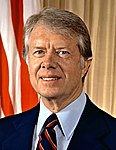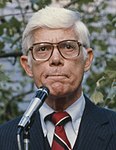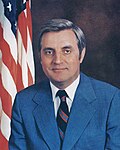
The 1988 United States presidential election was the 51st quadrennial presidential election held on Tuesday, November 8, 1988. In what was the third consecutive landslide election for the Republican Party, their ticket of incumbent Vice President George H. W. Bush and Indiana senator Dan Quayle defeated the Democratic ticket of Massachusetts Governor Michael Dukakis and Texas senator Lloyd Bentsen.
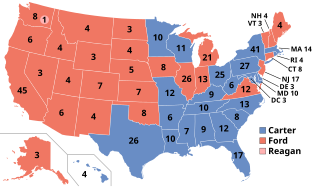
The 1976 United States presidential election was the 48th quadrennial presidential election, held on Tuesday, November 2, 1976. The Democratic nominee, former Georgia governor Jimmy Carter, narrowly defeated incumbent Republican President Gerald Ford. This was the first presidential election since 1932 in which the incumbent was defeated, as well as the only Democratic victory of the six presidential elections between 1968 and 1988.

The 1980 United States presidential election was the 49th quadrennial presidential election, held on November 4, 1980. The Republican nominee, former California governor Ronald Reagan, defeated incumbent Democratic President Jimmy Carter in a landslide victory. This was the first election since 1932 in which an elected incumbent president was defeated, as well as the first election since 1888 that saw the defeat of an incumbent Democratic president.

The 1984 United States presidential election was the 50th quadrennial presidential election, held on Tuesday, November 6, 1984. Incumbent Republican President Ronald Reagan and his running mate, incumbent Vice President George H. W. Bush, were reelected to a second term in a landslide. They defeated the Democratic ticket of former Vice President Walter Mondale and Congresswoman Geraldine Ferraro.
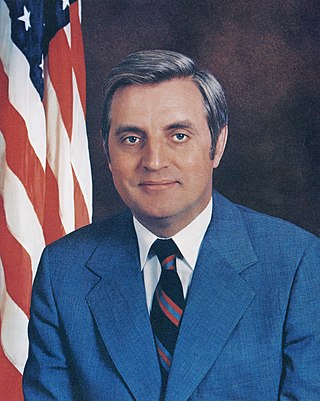
Walter Frederick "Fritz" Mondale was an American lawyer and politician who served as the 42nd vice president of the United States from 1977 to 1981 under President Jimmy Carter. he previously served as a U.S. senator from Minnesota from 1964 to 1976, he was the Democratic Party's nominee in the 1984 presidential election, but lost to incumbent Ronald Reagan in an Electoral College and popular vote landslide.

John Bayard Anderson was an American lawyer and politician who served in the United States House of Representatives, representing Illinois's 16th congressional district from 1961 to 1981. A member of the Republican Party, he also served as the Chairman of the House Republican Conference from 1969 until 1979. In 1980, he ran an independent campaign for president, receiving 6.6% of the popular vote.

During presidential election campaigns in the United States, it has become customary for the candidates to engage in one or more debates. The topics discussed in the debate are often the most controversial issues of the time, and arguably elections have been nearly decided by these debates. Candidate debates are not constitutionally mandated, but they are now considered an intrinsic part of the election process. The debates are targeted mainly at undecided voters; those who tend not to be partial to any political ideology or party.

Patrick Joseph Lucey was an American politician. A member of the Democratic Party, he served as the 38th Governor of Wisconsin from 1971 to 1977. He was also independent presidential candidate John B. Anderson's running mate in the 1980 presidential election.

The Commission on Presidential Debates (CPD) is a nonprofit corporation established in 1987 under the joint sponsorship of the Democratic and Republican political parties in the United States. The CPD sponsors and produces debates for U.S. presidential and vice-presidential candidates and undertakes research and educational activities relating to the debates. Between 1988 and 2020, the CPD organized all general election presidential debates.

From January 21 to June 3, 1980, voters of the Republican Party chose its nominee for president in the 1980 United States presidential election. Retired Hollywood actor and two-term California governor Ronald Reagan was selected as the nominee through a series of primary elections and caucuses culminating in the Republican National Convention held from July 14 to 17, 1980, in Detroit, Michigan.

In the 1980 United States presidential election, Ronald Reagan and his running mate, George H. W. Bush, were elected president and vice president, defeating incumbents Jimmy Carter and Walter Mondale of the Democratic Party.

The 1980 United States presidential election in New Jersey took place on November 4, 1980. All 50 states and the District of Columbia, were part of the 1980 United States presidential election. Voters chose seventeen electors to the Electoral College, which selected the president and vice president.

The 1980 United States presidential election in Minnesota took place on November 4, 1980, as part of the 1980 United States presidential election. State voters chose ten representatives, or electors to the Electoral College, who voted for President and Vice-president.

The 1980 United States presidential election in Illinois took place on November 4, 1980. All 50 states and The District of Columbia, were part of the 1980 United States presidential election. State voters chose 26 electors to the Electoral College, who voted for president and vice president. Illinois voters chose between the Democratic ticket of incumbent president Jimmy Carter and vice president Walter Mondale, and the Republican ticket of Ronald Reagan and running mate George H. W. Bush, as well as the independent candidacy of John B. Anderson and running mate Patrick Lucey.

The 1980 United States presidential election in Wisconsin took place on November 4, 1980. All 50 states and The District of Columbia, were part of the 1980 United States presidential election. State voters chose eight electors to the Electoral College, who voted for president and vice president.

The Walter Mondale 1984 presidential campaign began on February 21, 1983, when Walter Mondale, a former Minnesota senator and vice president of the United States, announced that he was running for president in a speech at the Minnesota State Capitol. Mondale won the Democratic Party's presidential nomination after convincing Frank Lautenberg, a previously unpledged party delegate, to support him. Lautenberg's vote gave Mondale the 1,967 delegate votes needed to become the Democratic Party's nominee. Mondale picked Geraldine Ferraro, a U.S. representative from New York, as his running mate. Mondale lost the general election, held on November 6, 1984, to incumbent Republican President Ronald Reagan in a landslide. Had Mondale been elected, he would have been the first U.S. president from Minnesota and the first non-incumbent vice president since Richard Nixon to take office as president. Ferraro would also have been the country's first female vice president, and the first person from New York since Nelson Rockefeller to become vice president, whereas her husband, John Zaccaro, would also have been the country's first second gentleman.
The 1984 United States presidential debates a series of debates held during the 1984 presidential election.

In the 1984 United States presidential election, Ronald Reagan and George H. W. Bush were reelected president and vice president over Walter Mondale and Geraldine Ferraro of the Democratic Party.
In the 1976 United States presidential election, Jimmy Carter and his running mate, Walter Mondale, were elected president and vice president, defeating incumbent Republican president Gerald Ford and his running mate, Bob Dole.

In the 1980 United States presidential election, incumbent president Jimmy Carter and incumbent vice president Walter Mondale were defeated by Republican presidential nominee Ronald Reagan and vice presidential nominee George H. W. Bush.
